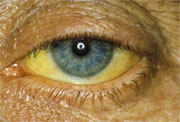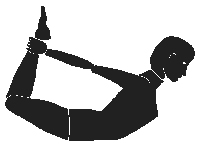Introduction

The main symptoms of jaundice are the characteristic yellowish colour of the skin, sclera (whites) of the eyes, nail beds and tongue. Other symptoms usually depend on the actual cause of the jaundice. In some types of jaundice, bilirubin is excreted in the urine, which becomes yellowish brown in colour. If the excretion of bile is obstructed, stools are almost white and the digestion of fat is consequently impaired. If the jaundice has been present for a long time, pruritis (intense itching) may occur. In jaundice, due to obstruction, lipid deposits on the skin such as xanthelesmas on the eyelids or xanthomas can develop. Some patients with jaundice may also have vomiting, and abdominal pain, malaise, severe weakness etc. Complications include hepatic failure with its attendant complications such as bleeding, vomiting of blood, accumulation of fluid in the abdomen (ascites), and a condition called hepatic encephalopathy where the patient has altered consciousness and later coma. In the very mild infective instances of jaundice, home care may be adequate, whereas a fulminant case of jaundice may require intensive care and monitoring. A number of drugs belonging to the Indian, Chinese and European herbal traditions are available in the market.
Yoga and Jaundice
The word yoga means union and the unifying aspect of all forms of yoga are yoga meditation. While all religions encourage some form of meditation, it may be surprising to learn that science also encourages it as a way to manage stress and increase cardiovascular health. Unlike earlier, Yoga today is no longer restricted to a privileged minority of hermits; it has taken its place in our every day lives and have undergone a world wide awakening and acceptance in the last few decades. The Science of Yoga and its techniques have now been re-oriented to suit modern sociological needs and lifestyle. Experts of various branches of medicine including modern medical science are realizing the role of these techniques in the prevention of disease and promotion of health. Yoga creates specific effects to strengthen and tone the nerves, glands and organs of the body and ultimately draw the mind and senses inward to experience a deeper state of consciousness, a feeling of blissful union with spirit.YOGA POSES FOR JAUNDICE
Happy Baby Pose
This posture helps to strengthen your sense of balance and concentration. The arch formed by the back and stretched leg gently aligns the vertebrae of the spine restoring suppleness and easing strain caused by poor posture or long periods of sitting. It tones the muscles of the hips and legs as well as stimulates the chest muscles.Bound Lotus Pose
A position which is said to destroy all diseases, this position cures constipation and does wonders to the digestive powers of the body. The bound lotus pose is one of the most advanced yoga poses; however, it offers an incredible stretch to the legs, arms and spine. Because this pose can take years to perfect, even for advanced yogis, practicing with yoga straps not only makes the pose more comfortable, but it also helps you move more quickly into the full pose.Fish Pose
Fish pose is another important yoga posture which helps in providing relief from tension and relaxes the mind and the body. It eases the pressure on the mind and provides support to the back and the shoulders. It is a comfortable Yoga pose which does not cause strain to the other organs of the body.Sun Salutation
Sun Salution is one of the more common postures within Yoga. This particular exercise not only stretches your spine and joints, but also works to regulate your breathing, calm your mind, and energize your body. Generally, Sun Salutation is used to begin a set of Yoga exercises. You can use it to begin your day.Root Squeezing Pose
It cures disorders of spleen and liver. Sit on the ground with heels near navel and reverted toes of the feet pressed to abdomen. Hands should be placed either on knees or near chest.YOGA ASANAS FOR JAUNDICE
MATSYASANA

Steps
- Sit with your legs fully stretched out. Bend each leg at the knees and place your feet on the other hip joint. Both the heels are adjusted in such a way that each presses the adjacent portion of the abdomen. This forms the foot-lock in a sitting position.
- Bend backwards and, exhaling, rest your weight on the elbows. Push your neck backwards and slightly rise the hip upward thus making an arch of the spine.
- Then, by making hooks of the forefingers, hold your toes on the corresponding side without crossing your arms. This posture should be maintained for some time with slow and deep breathing.
- For reverting to the original position, release the foot-lock and return to the supine position by lowering the arch.
SHIRSHASANA

Steps
- Sit on soles. place knees on the ground.
- Frame finger lock with both hands.
- Making a triangle from finger-lock and elbows, place it on ground.
- Now straighten your legs.
- Slowly bring the legs neck your body.
- Soles will automatically leave the ground by practice and thighs knees will touch the abdomen.
- Now keeping the balance straighten your legs from thigh-joint, knees will remain folded.
- Now straighten the knees also and completely balance your body on head.
- While returning to the original position fold your knee first. Then fold your legs from thigh and let the thigh and knee touch your abdomen.
- Now slowly place the soles on the ground. Slowly raise your head also and sit on soles.
SARVANGASANA

Steps
- Lie straight, on your back on the floor. Palms should be on the floor close to the body and the heels and the toes should be together.
- Inhale and raise both the legs slowly up in a vertical position (at 90o). Raising of the legs should be synchronized with the breathing.
- Exhale and again raise the legs upward from the second position. Bring both palms underneath the hips and should be used to assist in raising the body upwards. The hands should always work as a support to the body weight.
- Try to raise the body as straight as possible.
- At the final stage of this asana you will be resting on your shoulders, chin touching the chest. In this position the legs should be stiff hard and together and the toes is pointing towards the ceiling. Do not shake. Be firm and keep breathing normally.
- Remain in this position for about 30 seconds on the first day.
- For returning to the first position, first fold the legs on the knees. Your heels should be now on the thighs and above the buttock. Then slowly let the body return to the floor while the palms are supporting the body weight.
- Now stretch out the legs forwards and relax. You have completed one round of the Sarvanga Asana.
SHAVASANA

Steps
- Lie on the back.
- Keep your spine, navel & pelvic in one line.
- Keep feet apart.
- Keep arms on the each side of body, palms facing to sky.
- Keep neck right or left side.
- Close your eyes & slowly try to concentrate each part of the body & try to relax that part.
DHANURASANA

Steps
- Take prone lying position, legs together, hands straight by the side of the thighs, chin resting on the ground. Fold the legs at the knees and bring them on the thighs. Knees must remain together.
- Bring your hands backward and hold the toes of respective legs from the thumb and forefinger of the respective hands.
- Raise your legs a little up and simultaneously raise your head and chest.
- Holding the toes pull the legs towards ears and bring the toes near the ear. Gaze in front.
- While returning to this original position, loosen your hands, take legs backward, let the thighs touch the ground, leave the toes and ultimately bring the legs and hand to the first position
Diseases Related to Cancer |
||


